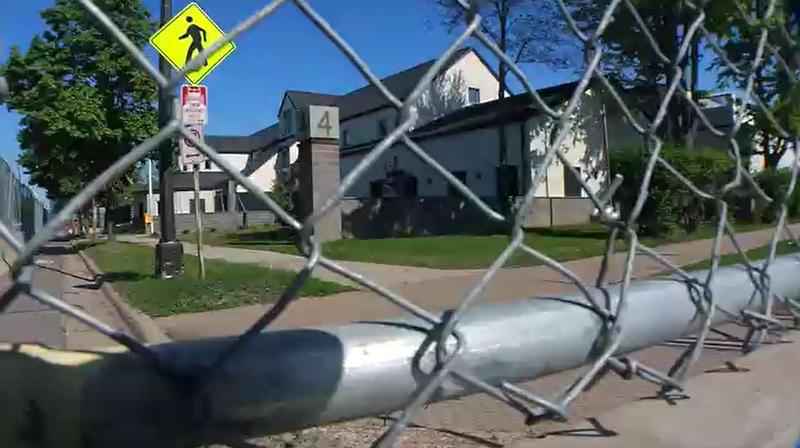No firm plans on barricades surrounding MPD precincts, one year after one burned down
[anvplayer video=”5032736″ station=”998122″]
The violence, destruction, and unrest that Cedric Powell has witnessed at 9 years old is more than some experience in a lifetime.
He regularly plays at his grandmother’s house in north Minneapolis in the shadows of barbed wire fencing, operating his remote-controlled car past concrete barriers and feet from a charred parking spot where a police cruiser was set on fire last year.
“I’m sick and tired of it. I want this gone,” said Powell’s grandma, Patricia Anderson, who has lived across from the Minneapolis Police Department’s 4th Precinct for 11 years.
One year after rioters torched the 3rd Precinct in Minneapolis, there are no firm plans in place to bring down the barricades that are protecting police stations around the city.
While neighbors are pushing for the barriers to be dismantled this summer, police say the military-like safety measures may have to go right back up in the future.

[KSTP]
“We are just one incident away from further unrest,” said Inspector Charlie Adams of the 4th Precinct in north Minneapolis.
Police stations have been targets for outrage and civil unrest since the death of George Floyd last May.
Locals not feeling at ease with increased security at Minneapolis precincts
MPD admits it was not prepared last summer to thwart rioters from overtaking the third precinct and setting it on fire — but now it’s clearly different.
Every precinct around the city is surrounded by military-style cement barricades, tall fencing, and barbed fire to protect the building and officers inside.
“I’d love to keep it for 30 more days,” Adams said during a recent interview with 5 INVESTIGATES. “Things have not really calmed down.”
But some in the community are beginning to resent the look of a police station literally barricaded from the neighborhood it serves.
“I don’t want to see that every day — just looking at my bedroom window and I see these barricades, and I feel like I’m in another country,” Anderson said.
In the 11 years Anderson has lived across from the 4th Precinct, she has been forced to flee her home twice in that time: once during the occupation of the 4th Precinct following the death of Jamar Clark and again during the protests after the death of George Floyd.
She says her children and grandchildren have had a “front-row seat” to the protests and riots and believes the barricades make it hard to move on.
“They’ve already seen and heard way more than they should have.”
Minneapolis City Council member Andrea Jenkins also believes it’s time for the fencing and barricades to come down and for the community to return to some semblance of normalcy.
“I think the police have to take a step towards the building back as a part of the community, as opposed to standing apart from the community. And that’s what those barricades and barriers represent to me,” she said.
But police say those extra security measures, from boarded-up windows to barbed wire fencing, have been necessary not just to protect the precinct but also to keep officers safe.
Adams, who grew up in north Minneapolis and now leads the 4th Precinct, tells 5 INVESTIGATES that the future plans remain fluid and the final decision rests with Chief Medaria Arradondo.
Adams insists that, despite the barricades, the precinct remains part of and open to the neighborhood it serves. While he doesn’t like it, he says it’s necessary after what transpired nearly a year ago at the 3rd Precinct.
Since that police station burned down last summer, another police station was set on fire in Seattle back in August after rioters tried to trap officers inside.
Last month, a cement barrier went up outside the Brooklyn Center police station hours after the death of Daunte Wright, followed by a second wall days later.
“They were intent to burn the building down,” said Sheriff David Hutchinson during a recent interview in which he defended the tactics used on protestors and the security measures to keep officers safe.
The barriers in Brooklyn Center remain in place just like in Minneapolis, where Anderson tries to keep her three grandkids occupied outside to distract them from the intimidating fortress across the street.
“I’m sick and tired of it. I want this gone, and I want my life back," she said. "I want my grandkids’ lives back, and just my community, my community as a whole.”